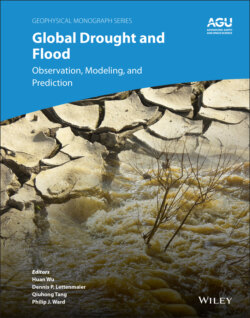Читать книгу Global Drought and Flood - Группа авторов - Страница 24
1.4. DROUGHT AND HEATWAVES FEEDBACKS
ОглавлениеThe occurrence of flash droughts that are caused by heatwaves, unlike those due to the lack of precipitation, often cannot be monitored properly, and hence early warning systems fail to prevent losses. High temperatures associated with heatwaves reduce soil moisture and increase ET, thereby having a direct impact on the agricultural sector (Mo & Lettenmaier, 2015). The Risk Management Agency of the United States Department of Agriculture (USDA; https://www.rma.usda.gov/data/sob.html) reports that livestock stress due to withering of crops sustains economic losses that are billions of dollars. Heatwaves have also contributed to a decrease in efficiency of power plants (Zamuda et al., 2013), an increase in air pollution and therefore proliferating mortality, respiratory and cardiovascular morbidity (Poumadere et al., 2005), an increase in intensity, duration, and size of wildfires that takes a toll on the economy in several ways (Zamuda et al., 2013). A sequence of multiple extreme climate events can cause catastrophic disasters and are recognized by the Intergovernmental Panel on Climate Change (IPCC) as compound events (Leonard et al., 2014). Chiang et al. (2018), utilizing historical observations from Climate Research Unit (CRU), detected that in southern and northeastern United States, warming rates associated with droughts have been rising faster than average climate. They found, however, that the accelerated warming associated with droughts does not hold for arid or semiarid regions. The United Nations Environment Program reported that the European heatwave in 2003 was the world’s most costly weather disaster (Mazdiyasni & AghaKouchak, 2015). During 2003, multiple European countries faced an unprecedented heatwave that increased ozone concentrations and imposed substantial health‐related issues on the population (Poumadere et al., 2005).
In a recent study by Miralles et al. (2014), persistent atmospheric pressure patterns were found to have caused land–atmosphere feedbacks leading to extreme temperatures and megaheatwaves in the summers of both 2003 in France and 2010 in Russia (Figure 1.11). The process can be described in two parts: (a) during daytime where the heat is provided by a large‐scale horizontal advection that warms both the desiccated land surface and atmospheric boundary layer, and (b) during nighttime when the heat produced during the day is entrapped in the atmospheric layer high above waiting to reenter the atmospheric boundary layer following the next diurnal cycle. Given that the process could continue for several consecutive days, Miralles et al. (2014) suggested that this combination of multiday memory of land surface and atmospheric boundary layer could explain the occurrence of megaheatwaves. Hirschi et al. (2011) established a relationship between soil moisture deficit and hot summer extremes in southern Europe using quantile regression and found a higher correlation for the high end of the distribution of temperature extremes. The relationship between soil moisture deficit and hot summer extremes, therefore, can be used as an early warning tool for extreme heatwaves and associated drought. As soil moisture availability is lowered, sensible heat flux causes atmospheric heating while evaporative cooling is reduced. This affects the energy balance and can be used as an early warning for monitoring hot extremes and flash droughts caused by heatwaves. In a study by Mueller and Seneviratne (2012), it was found that hot extremes are often followed by a surface moisture deficit globally. Their results from quantile regressions indicated that both low and high number of hot days (NHD; number of days that the maximum temperature exceeds the 90th percentile) per month occur following a dry condition whereas, wet conditions occur prior to low NHD.
Figure 1.11 Temperature anomalies by the Moderate Resolution Imaging Spectroradiometer (MODIS) on NASA’s Terra satellite. (a) Compound heatwave and drought hazards in Russia during summer of 2010. (b) The unprecedented heatwave in Australia between 7 and 14 February 2017.
(Courtesy of NASA’s earth observatory: https://earthobservatory.nasa.gov/images)
Heatwaves, especially in Europe, are usually caused by two feedback mechanisms of high sensible heat emissions and upper‐air anticyclonic circulations, with the latter having more drastic effects (Cassou et al., 2005). Studies over Europe suggest that it is possible to have hot summers succeeding a normal or even wet winter and spring conditions, if the land surfaces are desiccated. The desiccated land surface in the Mediterranean region forms a dry air that diminishes clouds and reduces convection and the dry air is transported to the north by a southerly wind, where it dramatically increases temperature and ultimately evapotranspiration demand of vegetation. Rossby wave trains arising from sea surface temperature anomalies in the tropical Atlantic are an example of anticyclonic circulations that result in heatwaves and droughts (Cassou et al., 2005). Ferranti and Viterbo (2006) argued that the formation of desiccated soil reduces energy evaporated as latent heat while increasing sensible heat, which in turn enhances the ratio of sensible over latent heat fluxes. Accordingly, the dry soil increases the thickness of the lower layer of the troposphere that favors the development of anticyclonic circulation anomalies. Warmer sea surface temperatures in the Mediterranean Sea also contributes to development of anticyclonic circulations; nevertheless, soil moisture content at the beginning of summer is the major determining factor for development of concurrent summer heatwaves and flash droughts (Feudale & Shukla, 2007; Zampieri et al., 2009). The concurrence of heatwaves and droughts has yet to be fully explored and further global scale studies are required for developing appropriate strategies to mitigate drought‐related losses.
